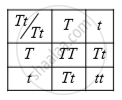Advertisements
Advertisements
प्रश्न
In Mendel’s experiments, tall pea plants (T) are dominant over dwarf pea plants (t).
Draw a Punnett square board to show the gametes and offspring when both the parents are heterozygous for tallness.
उत्तर

APPEARS IN
संबंधित प्रश्न
Explain the law of independent assortment with a suitable example.
Which one of the following is the phenotypic monohybrid ratio in F2 generation?
State whether the following statement is true or false:
The dominant character masks the recessive character.
Given below is a schematic diagram showing Mendel’s Experiment on sweet pea plants having axial flowers with round seeds (AARR) and Terminal flowers with wrinkled seeds (aarr). Study the same and answer the questions that follow :

(i) Give the phenotype of F1 progeny.
(ii) Give the phenotypes of F2 progeny produced upon by the self-pollination of F1 progeny.
(iii) Give the phenotypic ratio of F2 progeny.
(iv) Name and explain the law induced by Mendel on the basis of the above observation.
The crossing of F1 to homozygous recessive parent is called ______.
If Mendel had studied the seven traits using a plant with 12 chromosomes instead of 14, in what way would his interpretation have been different?
What is the probability of production of dwarf offsprings in a cross between two heterozygous tall pea plants?
Read the following and answer from given below:
Prashant wanted to find the genotype of a pea plant bearing purple coloured flowers in his kitchen garden. For this, he crossed purple-flowered plants with white-flowered plants. As a result, all plants which were produced had purple flowers only. Upon selfing these plants, 75 purple flower plants and 25 white flowers plants were produced. Now, he can determine the genotype of a purple-flowered plant by crossing it with a white-flowered plant.
In white-flowered plants, the allele is expressed in ______
Give reasons for the appearance of new combinations of characters in the F2 progeny.
Tall pea plants having green pods were crossed with dwarf pea plants having yellow pods. Out of 80 plants, how many are likely to be tall plants in the F2 generation?
